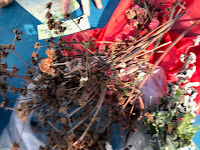Today Ms. Chaides' fourth grade students made succotash. This cooking experience is the culmination of the Three Sisters' Garden unit from their third grade year. Many Native American tribes planted a version of the Three Sisters' Garden with squash, corn and beans. Today we used a butternut squash harvested from a Marquez Three Sisters' garden as well as other vegetables donated by Gelson's.
Ms. Chaides' wrote the recipe on the board so the students could copy it onto recipe cards.
The amounts of vegetables and the colors of the peppers can be adjusted to suit your taste or what's on hand. We used yellow and red peppers to make the succotash colorful.
Succotash
· 3 tablespoons unsalted butter
3 tablespoons (T.) olive oil
· 2 cloves garlic, finely chopped
· ½-1 medium onion, cut into 1/4-inch dice
· 2 medium red bell peppers, seeded, deveined, and cut into 1/4-inch dice
· 3 medium zucchini, seeded and cut into 1/4-inch dice
· 1/2 ten-ounce packags frozen lima beans, rinsed under warm running water or defrosted and drained
· ½ bag of frozen green beans or similar amount of fresh beans
· 4 ears of corn
· Salt and freshly ground pepper to taste
· 1 tablespoon fresh thyme leaves
Note: we added 1/4 butternut squash cut in small pieces.
Directions:
1. Cut ingredients in small pieces. Scrape corn off the cobs.
2. Add butter and oil to pan and heat.
3. Add garlic and onion. Cook for 2 minutes
4. Add rest of ingredients and cook for 8-10 minutes until soft.
5. Save the vegetable scraps to compost.





















